Taxation Law Assignment: Analysis of CGT and Depreciation for T2 2019
VerifiedAdded on 2022/10/19
|10
|2410
|76
Homework Assignment
AI Summary
This taxation law assignment presents two comprehensive answers addressing key concepts of Australian taxation. The first answer analyzes the Capital Gains Tax (CGT) implications for an individual named Jasmine, evaluating the tax consequences of selling a house, car, cleaning business, furniture, and paintings, referencing the Income Tax Assessment Act 1997 and relevant sections. The second answer focuses on the depreciation of a Computer Numerical Control (CNC) machine, bought by John, examining the cost base calculation, including the first and second elements of asset cost, and determining the starting time for depreciation and the final price of the machine. The assignment applies relevant tax principles to provide a thorough analysis of each scenario.
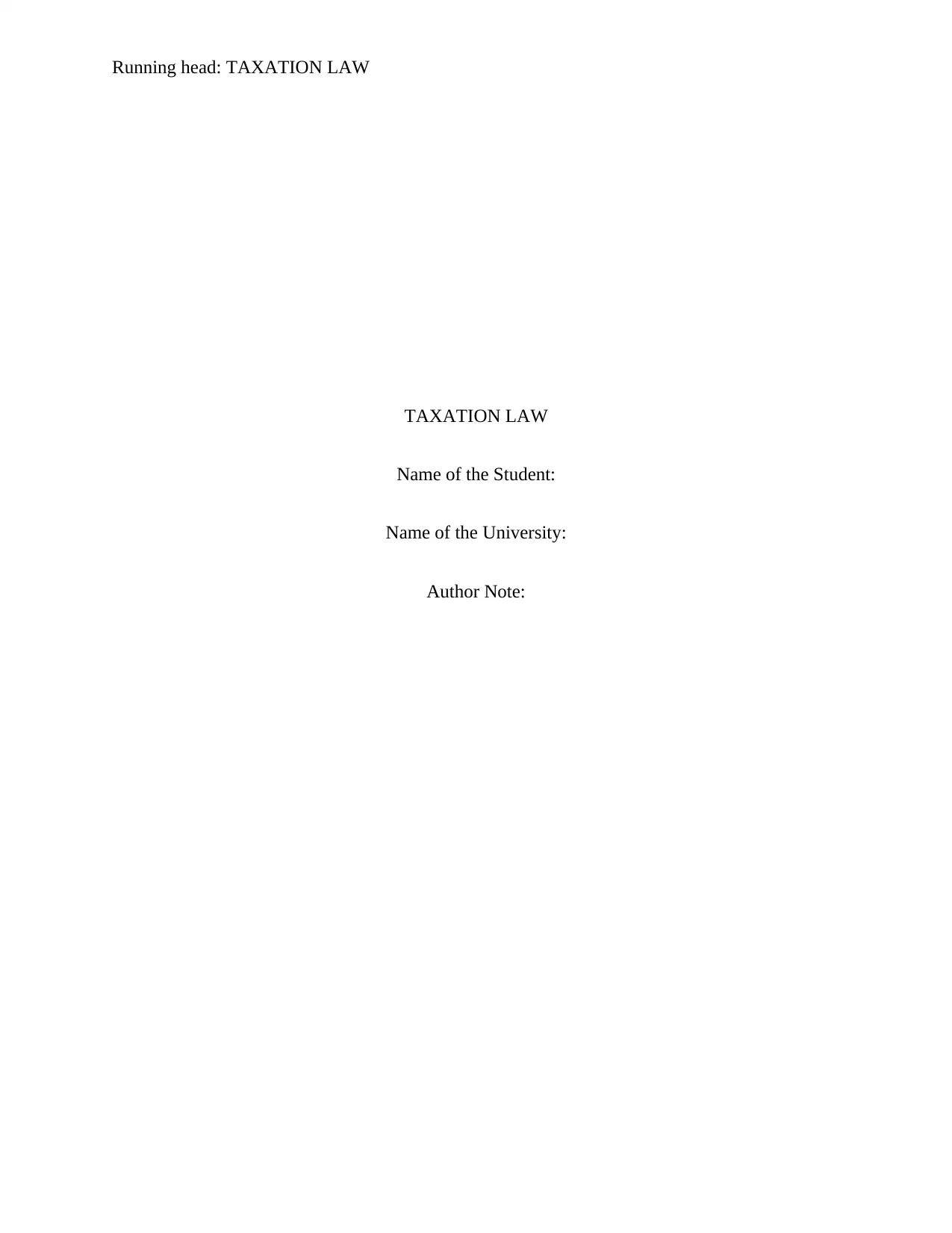
Running head: TAXATION LAW
TAXATION LAW
Name of the Student:
Name of the University:
Author Note:
TAXATION LAW
Name of the Student:
Name of the University:
Author Note:
Paraphrase This Document
Need a fresh take? Get an instant paraphrase of this document with our AI Paraphraser
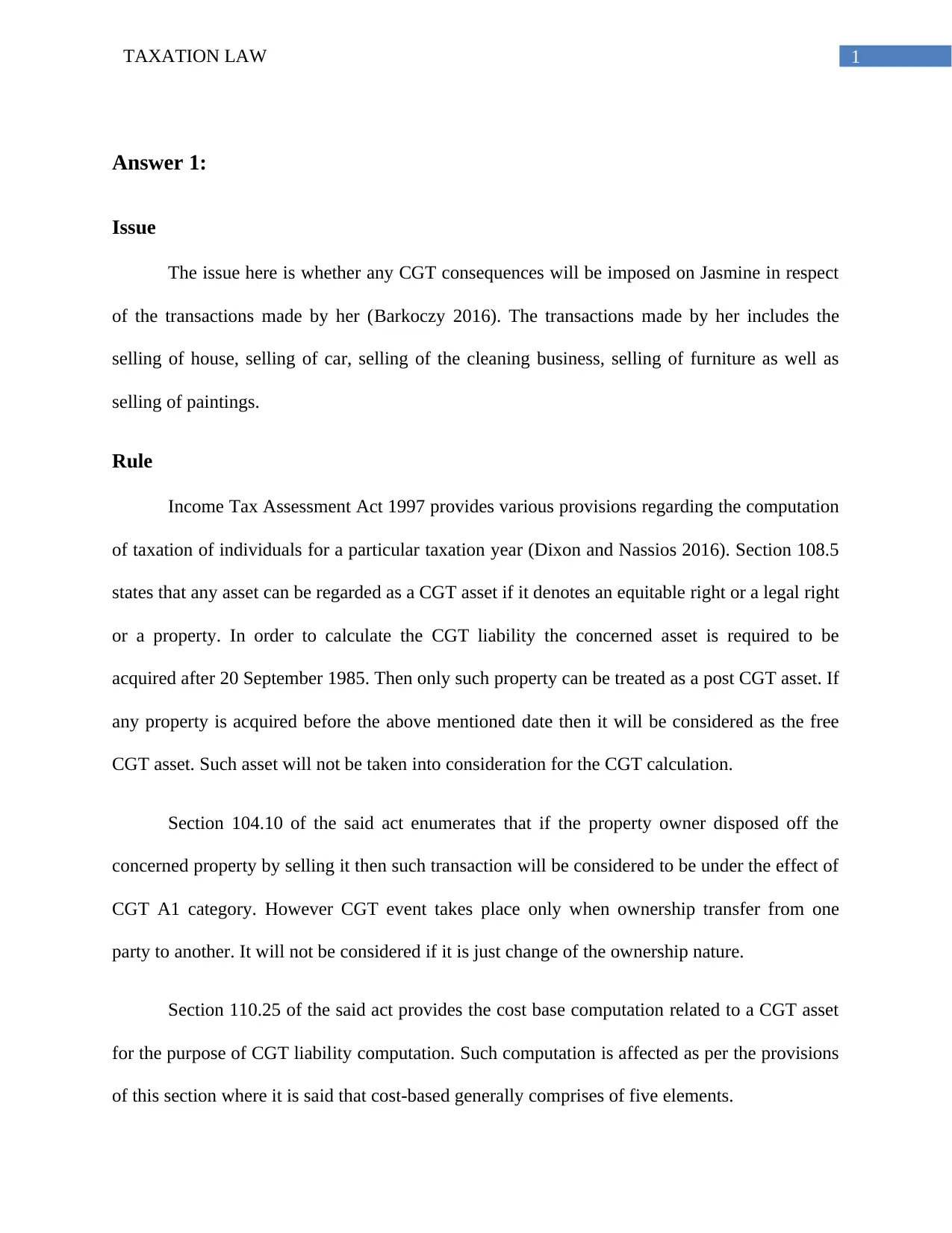
1TAXATION LAW
Answer 1:
Issue
The issue here is whether any CGT consequences will be imposed on Jasmine in respect
of the transactions made by her (Barkoczy 2016). The transactions made by her includes the
selling of house, selling of car, selling of the cleaning business, selling of furniture as well as
selling of paintings.
Rule
Income Tax Assessment Act 1997 provides various provisions regarding the computation
of taxation of individuals for a particular taxation year (Dixon and Nassios 2016). Section 108.5
states that any asset can be regarded as a CGT asset if it denotes an equitable right or a legal right
or a property. In order to calculate the CGT liability the concerned asset is required to be
acquired after 20 September 1985. Then only such property can be treated as a post CGT asset. If
any property is acquired before the above mentioned date then it will be considered as the free
CGT asset. Such asset will not be taken into consideration for the CGT calculation.
Section 104.10 of the said act enumerates that if the property owner disposed off the
concerned property by selling it then such transaction will be considered to be under the effect of
CGT A1 category. However CGT event takes place only when ownership transfer from one
party to another. It will not be considered if it is just change of the ownership nature.
Section 110.25 of the said act provides the cost base computation related to a CGT asset
for the purpose of CGT liability computation. Such computation is affected as per the provisions
of this section where it is said that cost-based generally comprises of five elements.
Answer 1:
Issue
The issue here is whether any CGT consequences will be imposed on Jasmine in respect
of the transactions made by her (Barkoczy 2016). The transactions made by her includes the
selling of house, selling of car, selling of the cleaning business, selling of furniture as well as
selling of paintings.
Rule
Income Tax Assessment Act 1997 provides various provisions regarding the computation
of taxation of individuals for a particular taxation year (Dixon and Nassios 2016). Section 108.5
states that any asset can be regarded as a CGT asset if it denotes an equitable right or a legal right
or a property. In order to calculate the CGT liability the concerned asset is required to be
acquired after 20 September 1985. Then only such property can be treated as a post CGT asset. If
any property is acquired before the above mentioned date then it will be considered as the free
CGT asset. Such asset will not be taken into consideration for the CGT calculation.
Section 104.10 of the said act enumerates that if the property owner disposed off the
concerned property by selling it then such transaction will be considered to be under the effect of
CGT A1 category. However CGT event takes place only when ownership transfer from one
party to another. It will not be considered if it is just change of the ownership nature.
Section 110.25 of the said act provides the cost base computation related to a CGT asset
for the purpose of CGT liability computation. Such computation is affected as per the provisions
of this section where it is said that cost-based generally comprises of five elements.
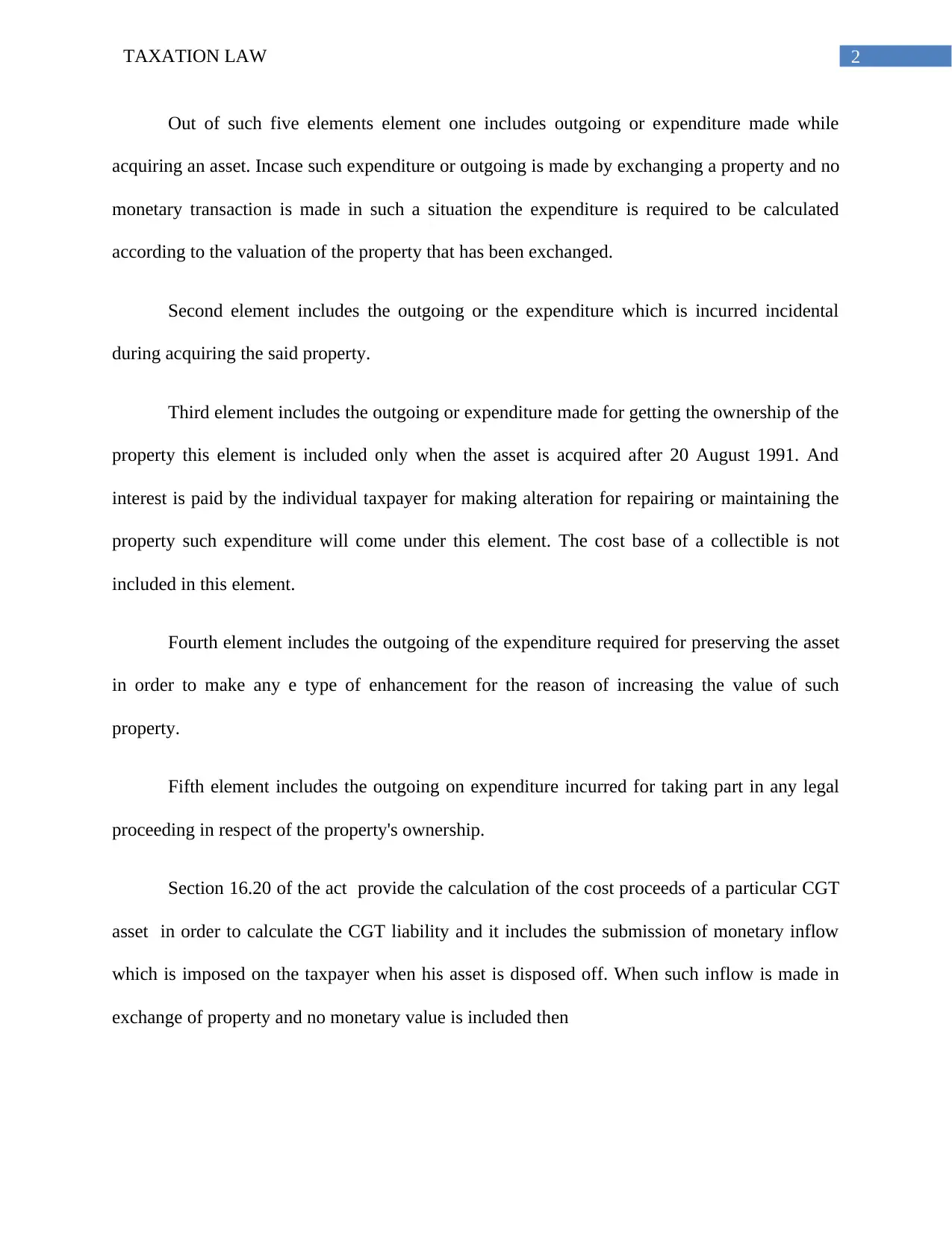
2TAXATION LAW
Out of such five elements element one includes outgoing or expenditure made while
acquiring an asset. Incase such expenditure or outgoing is made by exchanging a property and no
monetary transaction is made in such a situation the expenditure is required to be calculated
according to the valuation of the property that has been exchanged.
Second element includes the outgoing or the expenditure which is incurred incidental
during acquiring the said property.
Third element includes the outgoing or expenditure made for getting the ownership of the
property this element is included only when the asset is acquired after 20 August 1991. And
interest is paid by the individual taxpayer for making alteration for repairing or maintaining the
property such expenditure will come under this element. The cost base of a collectible is not
included in this element.
Fourth element includes the outgoing of the expenditure required for preserving the asset
in order to make any e type of enhancement for the reason of increasing the value of such
property.
Fifth element includes the outgoing on expenditure incurred for taking part in any legal
proceeding in respect of the property's ownership.
Section 16.20 of the act provide the calculation of the cost proceeds of a particular CGT
asset in order to calculate the CGT liability and it includes the submission of monetary inflow
which is imposed on the taxpayer when his asset is disposed off. When such inflow is made in
exchange of property and no monetary value is included then
Out of such five elements element one includes outgoing or expenditure made while
acquiring an asset. Incase such expenditure or outgoing is made by exchanging a property and no
monetary transaction is made in such a situation the expenditure is required to be calculated
according to the valuation of the property that has been exchanged.
Second element includes the outgoing or the expenditure which is incurred incidental
during acquiring the said property.
Third element includes the outgoing or expenditure made for getting the ownership of the
property this element is included only when the asset is acquired after 20 August 1991. And
interest is paid by the individual taxpayer for making alteration for repairing or maintaining the
property such expenditure will come under this element. The cost base of a collectible is not
included in this element.
Fourth element includes the outgoing of the expenditure required for preserving the asset
in order to make any e type of enhancement for the reason of increasing the value of such
property.
Fifth element includes the outgoing on expenditure incurred for taking part in any legal
proceeding in respect of the property's ownership.
Section 16.20 of the act provide the calculation of the cost proceeds of a particular CGT
asset in order to calculate the CGT liability and it includes the submission of monetary inflow
which is imposed on the taxpayer when his asset is disposed off. When such inflow is made in
exchange of property and no monetary value is included then
⊘ This is a preview!⊘
Do you want full access?
Subscribe today to unlock all pages.

Trusted by 1+ million students worldwide
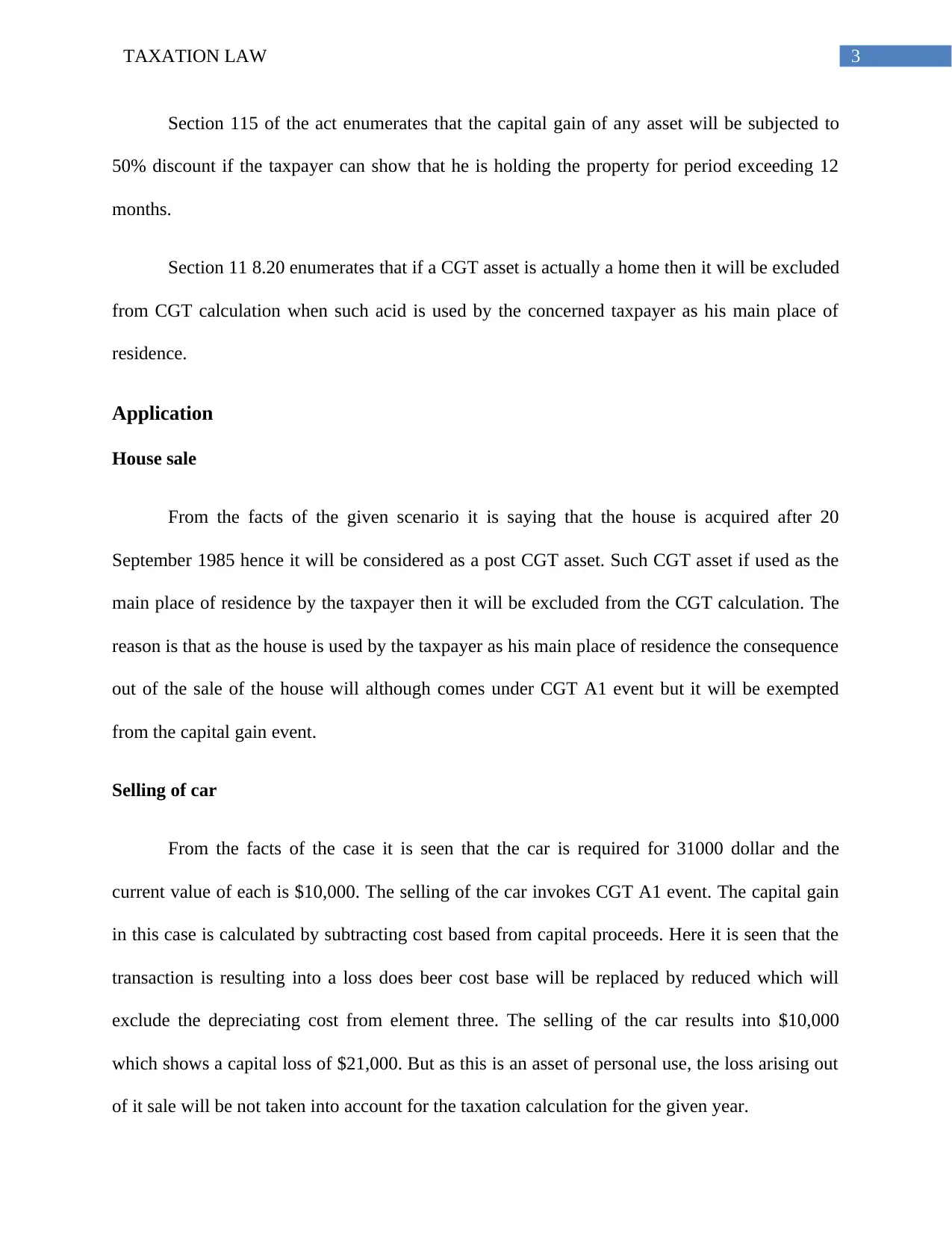
3TAXATION LAW
Section 115 of the act enumerates that the capital gain of any asset will be subjected to
50% discount if the taxpayer can show that he is holding the property for period exceeding 12
months.
Section 11 8.20 enumerates that if a CGT asset is actually a home then it will be excluded
from CGT calculation when such acid is used by the concerned taxpayer as his main place of
residence.
Application
House sale
From the facts of the given scenario it is saying that the house is acquired after 20
September 1985 hence it will be considered as a post CGT asset. Such CGT asset if used as the
main place of residence by the taxpayer then it will be excluded from the CGT calculation. The
reason is that as the house is used by the taxpayer as his main place of residence the consequence
out of the sale of the house will although comes under CGT A1 event but it will be exempted
from the capital gain event.
Selling of car
From the facts of the case it is seen that the car is required for 31000 dollar and the
current value of each is $10,000. The selling of the car invokes CGT A1 event. The capital gain
in this case is calculated by subtracting cost based from capital proceeds. Here it is seen that the
transaction is resulting into a loss does beer cost base will be replaced by reduced which will
exclude the depreciating cost from element three. The selling of the car results into $10,000
which shows a capital loss of $21,000. But as this is an asset of personal use, the loss arising out
of it sale will be not taken into account for the taxation calculation for the given year.
Section 115 of the act enumerates that the capital gain of any asset will be subjected to
50% discount if the taxpayer can show that he is holding the property for period exceeding 12
months.
Section 11 8.20 enumerates that if a CGT asset is actually a home then it will be excluded
from CGT calculation when such acid is used by the concerned taxpayer as his main place of
residence.
Application
House sale
From the facts of the given scenario it is saying that the house is acquired after 20
September 1985 hence it will be considered as a post CGT asset. Such CGT asset if used as the
main place of residence by the taxpayer then it will be excluded from the CGT calculation. The
reason is that as the house is used by the taxpayer as his main place of residence the consequence
out of the sale of the house will although comes under CGT A1 event but it will be exempted
from the capital gain event.
Selling of car
From the facts of the case it is seen that the car is required for 31000 dollar and the
current value of each is $10,000. The selling of the car invokes CGT A1 event. The capital gain
in this case is calculated by subtracting cost based from capital proceeds. Here it is seen that the
transaction is resulting into a loss does beer cost base will be replaced by reduced which will
exclude the depreciating cost from element three. The selling of the car results into $10,000
which shows a capital loss of $21,000. But as this is an asset of personal use, the loss arising out
of it sale will be not taken into account for the taxation calculation for the given year.
Paraphrase This Document
Need a fresh take? Get an instant paraphrase of this document with our AI Paraphraser
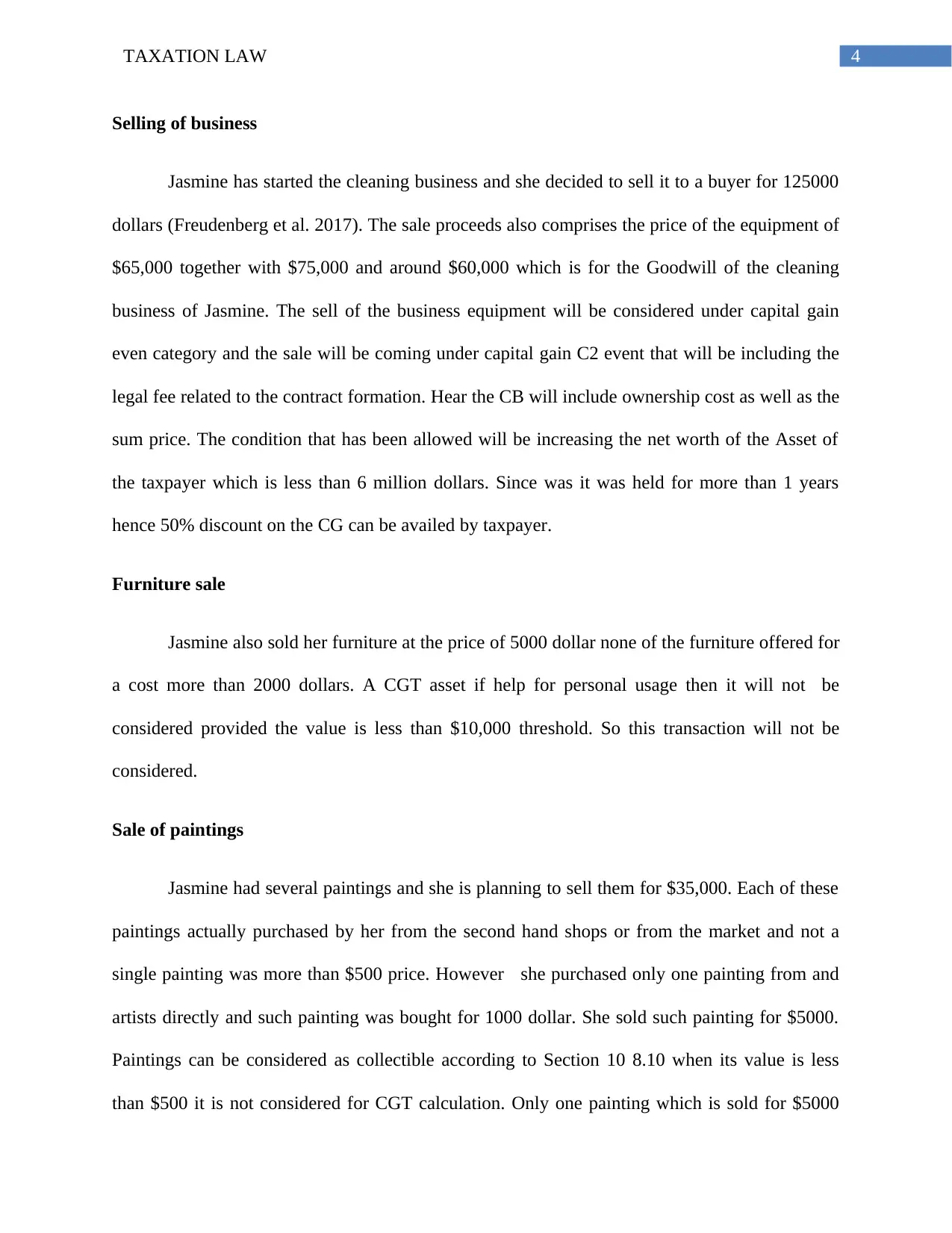
4TAXATION LAW
Selling of business
Jasmine has started the cleaning business and she decided to sell it to a buyer for 125000
dollars (Freudenberg et al. 2017). The sale proceeds also comprises the price of the equipment of
$65,000 together with $75,000 and around $60,000 which is for the Goodwill of the cleaning
business of Jasmine. The sell of the business equipment will be considered under capital gain
even category and the sale will be coming under capital gain C2 event that will be including the
legal fee related to the contract formation. Hear the CB will include ownership cost as well as the
sum price. The condition that has been allowed will be increasing the net worth of the Asset of
the taxpayer which is less than 6 million dollars. Since was it was held for more than 1 years
hence 50% discount on the CG can be availed by taxpayer.
Furniture sale
Jasmine also sold her furniture at the price of 5000 dollar none of the furniture offered for
a cost more than 2000 dollars. A CGT asset if help for personal usage then it will not be
considered provided the value is less than $10,000 threshold. So this transaction will not be
considered.
Sale of paintings
Jasmine had several paintings and she is planning to sell them for $35,000. Each of these
paintings actually purchased by her from the second hand shops or from the market and not a
single painting was more than $500 price. However she purchased only one painting from and
artists directly and such painting was bought for 1000 dollar. She sold such painting for $5000.
Paintings can be considered as collectible according to Section 10 8.10 when its value is less
than $500 it is not considered for CGT calculation. Only one painting which is sold for $5000
Selling of business
Jasmine has started the cleaning business and she decided to sell it to a buyer for 125000
dollars (Freudenberg et al. 2017). The sale proceeds also comprises the price of the equipment of
$65,000 together with $75,000 and around $60,000 which is for the Goodwill of the cleaning
business of Jasmine. The sell of the business equipment will be considered under capital gain
even category and the sale will be coming under capital gain C2 event that will be including the
legal fee related to the contract formation. Hear the CB will include ownership cost as well as the
sum price. The condition that has been allowed will be increasing the net worth of the Asset of
the taxpayer which is less than 6 million dollars. Since was it was held for more than 1 years
hence 50% discount on the CG can be availed by taxpayer.
Furniture sale
Jasmine also sold her furniture at the price of 5000 dollar none of the furniture offered for
a cost more than 2000 dollars. A CGT asset if help for personal usage then it will not be
considered provided the value is less than $10,000 threshold. So this transaction will not be
considered.
Sale of paintings
Jasmine had several paintings and she is planning to sell them for $35,000. Each of these
paintings actually purchased by her from the second hand shops or from the market and not a
single painting was more than $500 price. However she purchased only one painting from and
artists directly and such painting was bought for 1000 dollar. She sold such painting for $5000.
Paintings can be considered as collectible according to Section 10 8.10 when its value is less
than $500 it is not considered for CGT calculation. Only one painting which is sold for $5000
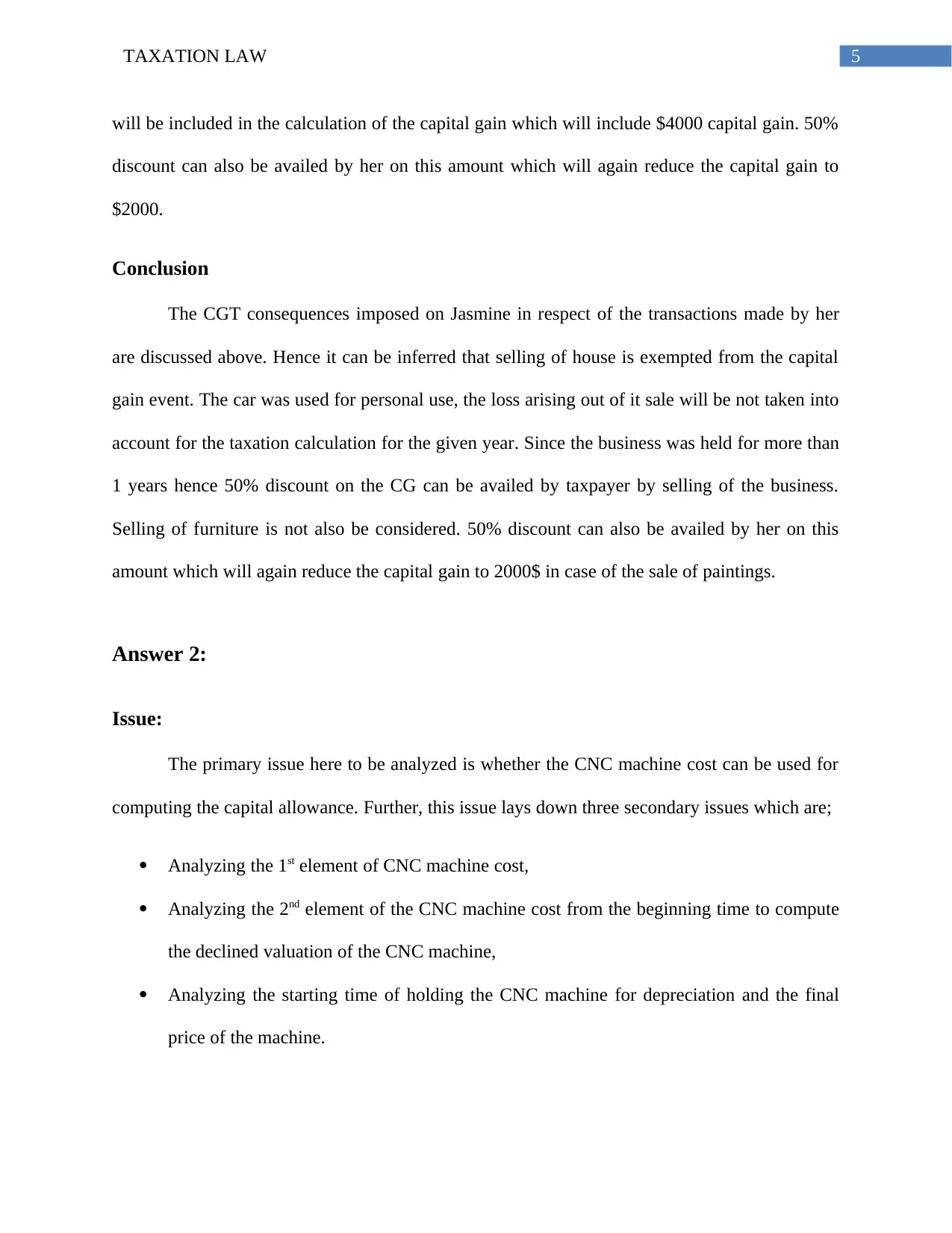
5TAXATION LAW
will be included in the calculation of the capital gain which will include $4000 capital gain. 50%
discount can also be availed by her on this amount which will again reduce the capital gain to
$2000.
Conclusion
The CGT consequences imposed on Jasmine in respect of the transactions made by her
are discussed above. Hence it can be inferred that selling of house is exempted from the capital
gain event. The car was used for personal use, the loss arising out of it sale will be not taken into
account for the taxation calculation for the given year. Since the business was held for more than
1 years hence 50% discount on the CG can be availed by taxpayer by selling of the business.
Selling of furniture is not also be considered. 50% discount can also be availed by her on this
amount which will again reduce the capital gain to 2000$ in case of the sale of paintings.
Answer 2:
Issue:
The primary issue here to be analyzed is whether the CNC machine cost can be used for
computing the capital allowance. Further, this issue lays down three secondary issues which are;
Analyzing the 1st element of CNC machine cost,
Analyzing the 2nd element of the CNC machine cost from the beginning time to compute
the declined valuation of the CNC machine,
Analyzing the starting time of holding the CNC machine for depreciation and the final
price of the machine.
will be included in the calculation of the capital gain which will include $4000 capital gain. 50%
discount can also be availed by her on this amount which will again reduce the capital gain to
$2000.
Conclusion
The CGT consequences imposed on Jasmine in respect of the transactions made by her
are discussed above. Hence it can be inferred that selling of house is exempted from the capital
gain event. The car was used for personal use, the loss arising out of it sale will be not taken into
account for the taxation calculation for the given year. Since the business was held for more than
1 years hence 50% discount on the CG can be availed by taxpayer by selling of the business.
Selling of furniture is not also be considered. 50% discount can also be availed by her on this
amount which will again reduce the capital gain to 2000$ in case of the sale of paintings.
Answer 2:
Issue:
The primary issue here to be analyzed is whether the CNC machine cost can be used for
computing the capital allowance. Further, this issue lays down three secondary issues which are;
Analyzing the 1st element of CNC machine cost,
Analyzing the 2nd element of the CNC machine cost from the beginning time to compute
the declined valuation of the CNC machine,
Analyzing the starting time of holding the CNC machine for depreciation and the final
price of the machine.
⊘ This is a preview!⊘
Do you want full access?
Subscribe today to unlock all pages.

Trusted by 1+ million students worldwide
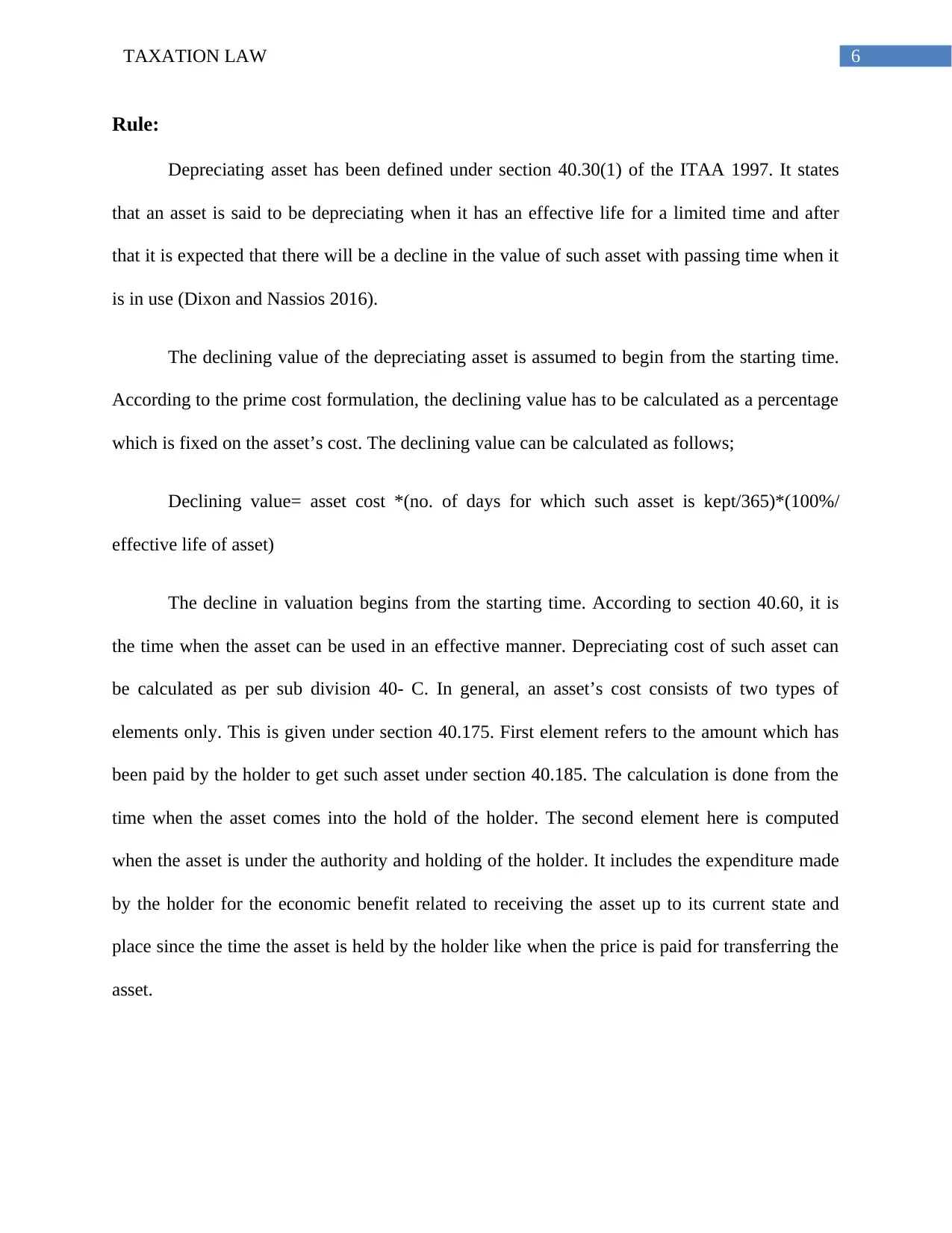
6TAXATION LAW
Rule:
Depreciating asset has been defined under section 40.30(1) of the ITAA 1997. It states
that an asset is said to be depreciating when it has an effective life for a limited time and after
that it is expected that there will be a decline in the value of such asset with passing time when it
is in use (Dixon and Nassios 2016).
The declining value of the depreciating asset is assumed to begin from the starting time.
According to the prime cost formulation, the declining value has to be calculated as a percentage
which is fixed on the asset’s cost. The declining value can be calculated as follows;
Declining value= asset cost *(no. of days for which such asset is kept/365)*(100%/
effective life of asset)
The decline in valuation begins from the starting time. According to section 40.60, it is
the time when the asset can be used in an effective manner. Depreciating cost of such asset can
be calculated as per sub division 40- C. In general, an asset’s cost consists of two types of
elements only. This is given under section 40.175. First element refers to the amount which has
been paid by the holder to get such asset under section 40.185. The calculation is done from the
time when the asset comes into the hold of the holder. The second element here is computed
when the asset is under the authority and holding of the holder. It includes the expenditure made
by the holder for the economic benefit related to receiving the asset up to its current state and
place since the time the asset is held by the holder like when the price is paid for transferring the
asset.
Rule:
Depreciating asset has been defined under section 40.30(1) of the ITAA 1997. It states
that an asset is said to be depreciating when it has an effective life for a limited time and after
that it is expected that there will be a decline in the value of such asset with passing time when it
is in use (Dixon and Nassios 2016).
The declining value of the depreciating asset is assumed to begin from the starting time.
According to the prime cost formulation, the declining value has to be calculated as a percentage
which is fixed on the asset’s cost. The declining value can be calculated as follows;
Declining value= asset cost *(no. of days for which such asset is kept/365)*(100%/
effective life of asset)
The decline in valuation begins from the starting time. According to section 40.60, it is
the time when the asset can be used in an effective manner. Depreciating cost of such asset can
be calculated as per sub division 40- C. In general, an asset’s cost consists of two types of
elements only. This is given under section 40.175. First element refers to the amount which has
been paid by the holder to get such asset under section 40.185. The calculation is done from the
time when the asset comes into the hold of the holder. The second element here is computed
when the asset is under the authority and holding of the holder. It includes the expenditure made
by the holder for the economic benefit related to receiving the asset up to its current state and
place since the time the asset is held by the holder like when the price is paid for transferring the
asset.
Paraphrase This Document
Need a fresh take? Get an instant paraphrase of this document with our AI Paraphraser
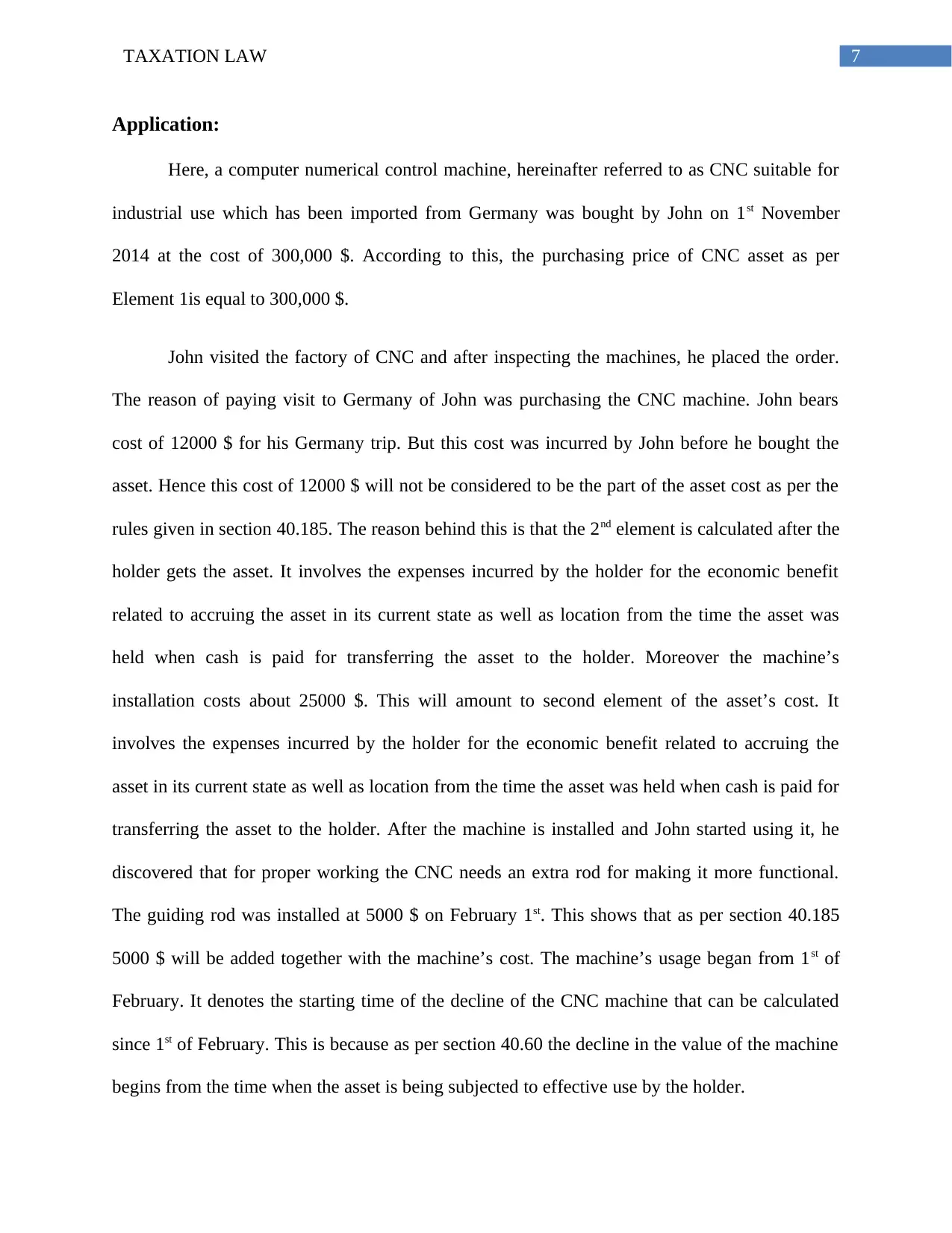
7TAXATION LAW
Application:
Here, a computer numerical control machine, hereinafter referred to as CNC suitable for
industrial use which has been imported from Germany was bought by John on 1st November
2014 at the cost of 300,000 $. According to this, the purchasing price of CNC asset as per
Element 1is equal to 300,000 $.
John visited the factory of CNC and after inspecting the machines, he placed the order.
The reason of paying visit to Germany of John was purchasing the CNC machine. John bears
cost of 12000 $ for his Germany trip. But this cost was incurred by John before he bought the
asset. Hence this cost of 12000 $ will not be considered to be the part of the asset cost as per the
rules given in section 40.185. The reason behind this is that the 2nd element is calculated after the
holder gets the asset. It involves the expenses incurred by the holder for the economic benefit
related to accruing the asset in its current state as well as location from the time the asset was
held when cash is paid for transferring the asset to the holder. Moreover the machine’s
installation costs about 25000 $. This will amount to second element of the asset’s cost. It
involves the expenses incurred by the holder for the economic benefit related to accruing the
asset in its current state as well as location from the time the asset was held when cash is paid for
transferring the asset to the holder. After the machine is installed and John started using it, he
discovered that for proper working the CNC needs an extra rod for making it more functional.
The guiding rod was installed at 5000 $ on February 1st. This shows that as per section 40.185
5000 $ will be added together with the machine’s cost. The machine’s usage began from 1st of
February. It denotes the starting time of the decline of the CNC machine that can be calculated
since 1st of February. This is because as per section 40.60 the decline in the value of the machine
begins from the time when the asset is being subjected to effective use by the holder.
Application:
Here, a computer numerical control machine, hereinafter referred to as CNC suitable for
industrial use which has been imported from Germany was bought by John on 1st November
2014 at the cost of 300,000 $. According to this, the purchasing price of CNC asset as per
Element 1is equal to 300,000 $.
John visited the factory of CNC and after inspecting the machines, he placed the order.
The reason of paying visit to Germany of John was purchasing the CNC machine. John bears
cost of 12000 $ for his Germany trip. But this cost was incurred by John before he bought the
asset. Hence this cost of 12000 $ will not be considered to be the part of the asset cost as per the
rules given in section 40.185. The reason behind this is that the 2nd element is calculated after the
holder gets the asset. It involves the expenses incurred by the holder for the economic benefit
related to accruing the asset in its current state as well as location from the time the asset was
held when cash is paid for transferring the asset to the holder. Moreover the machine’s
installation costs about 25000 $. This will amount to second element of the asset’s cost. It
involves the expenses incurred by the holder for the economic benefit related to accruing the
asset in its current state as well as location from the time the asset was held when cash is paid for
transferring the asset to the holder. After the machine is installed and John started using it, he
discovered that for proper working the CNC needs an extra rod for making it more functional.
The guiding rod was installed at 5000 $ on February 1st. This shows that as per section 40.185
5000 $ will be added together with the machine’s cost. The machine’s usage began from 1st of
February. It denotes the starting time of the decline of the CNC machine that can be calculated
since 1st of February. This is because as per section 40.60 the decline in the value of the machine
begins from the time when the asset is being subjected to effective use by the holder.
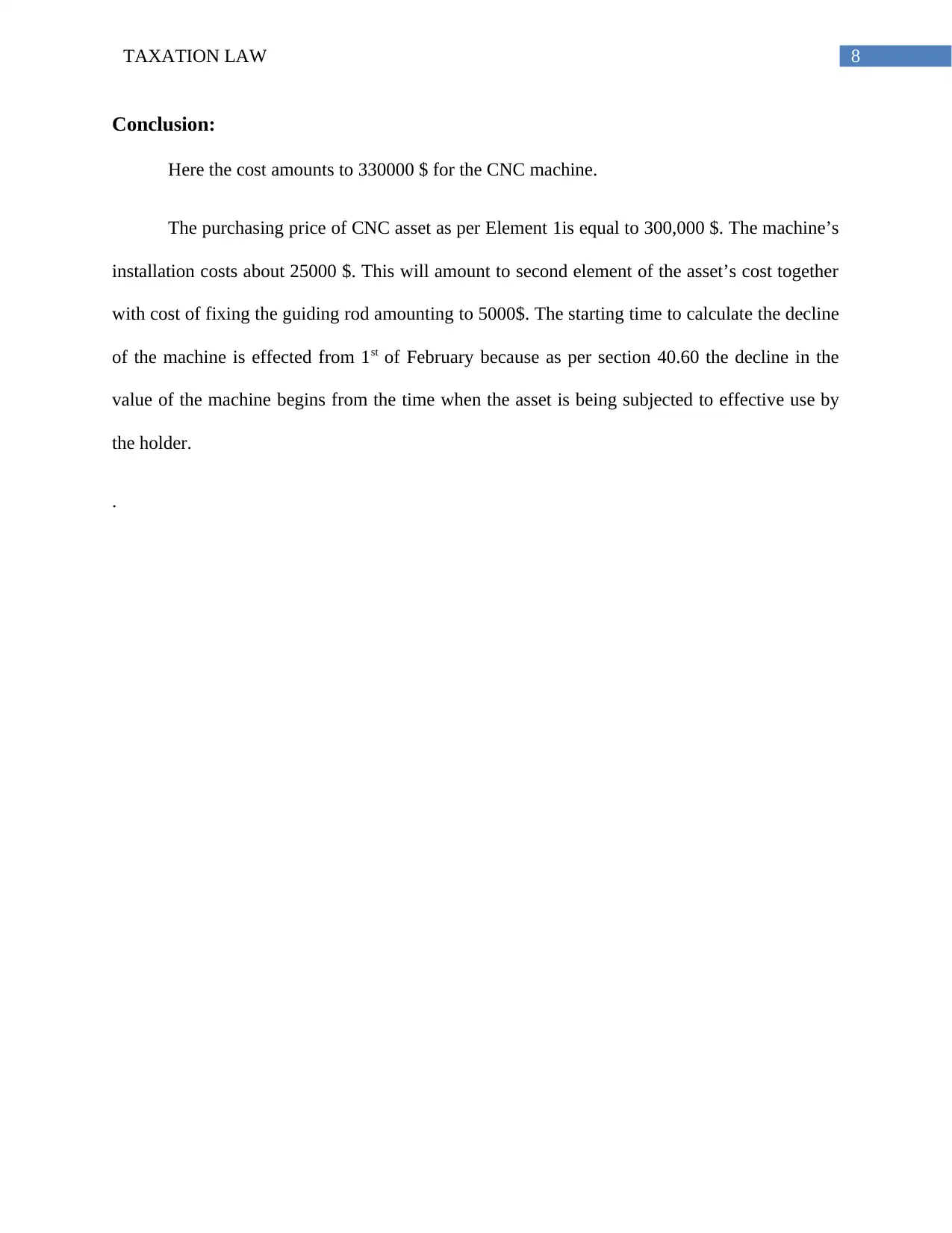
8TAXATION LAW
Conclusion:
Here the cost amounts to 330000 $ for the CNC machine.
The purchasing price of CNC asset as per Element 1is equal to 300,000 $. The machine’s
installation costs about 25000 $. This will amount to second element of the asset’s cost together
with cost of fixing the guiding rod amounting to 5000$. The starting time to calculate the decline
of the machine is effected from 1st of February because as per section 40.60 the decline in the
value of the machine begins from the time when the asset is being subjected to effective use by
the holder.
.
Conclusion:
Here the cost amounts to 330000 $ for the CNC machine.
The purchasing price of CNC asset as per Element 1is equal to 300,000 $. The machine’s
installation costs about 25000 $. This will amount to second element of the asset’s cost together
with cost of fixing the guiding rod amounting to 5000$. The starting time to calculate the decline
of the machine is effected from 1st of February because as per section 40.60 the decline in the
value of the machine begins from the time when the asset is being subjected to effective use by
the holder.
.
⊘ This is a preview!⊘
Do you want full access?
Subscribe today to unlock all pages.

Trusted by 1+ million students worldwide
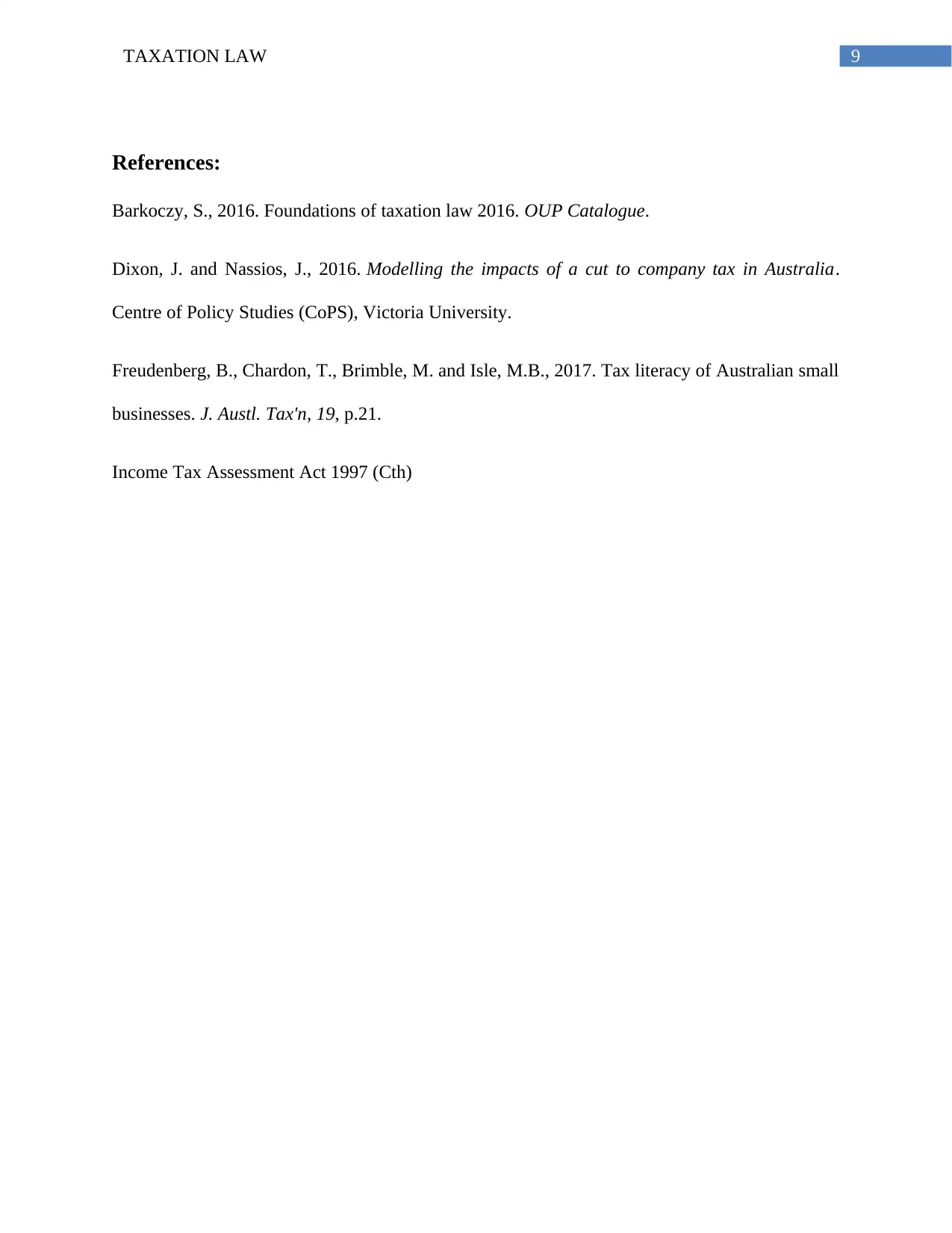
9TAXATION LAW
References:
Barkoczy, S., 2016. Foundations of taxation law 2016. OUP Catalogue.
Dixon, J. and Nassios, J., 2016. Modelling the impacts of a cut to company tax in Australia.
Centre of Policy Studies (CoPS), Victoria University.
Freudenberg, B., Chardon, T., Brimble, M. and Isle, M.B., 2017. Tax literacy of Australian small
businesses. J. Austl. Tax'n, 19, p.21.
Income Tax Assessment Act 1997 (Cth)
References:
Barkoczy, S., 2016. Foundations of taxation law 2016. OUP Catalogue.
Dixon, J. and Nassios, J., 2016. Modelling the impacts of a cut to company tax in Australia.
Centre of Policy Studies (CoPS), Victoria University.
Freudenberg, B., Chardon, T., Brimble, M. and Isle, M.B., 2017. Tax literacy of Australian small
businesses. J. Austl. Tax'n, 19, p.21.
Income Tax Assessment Act 1997 (Cth)
1 out of 10
Related Documents
Your All-in-One AI-Powered Toolkit for Academic Success.
+13062052269
info@desklib.com
Available 24*7 on WhatsApp / Email
![[object Object]](/_next/static/media/star-bottom.7253800d.svg)
Unlock your academic potential
Copyright © 2020–2025 A2Z Services. All Rights Reserved. Developed and managed by ZUCOL.




